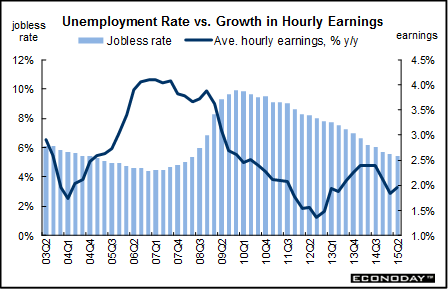
|
Long Term Perspective When the economy is operating at full throttle, a falling unemployment rate raises concern among policymakers that rapidly rising wages will turn into runaway inflation. In fact, wage growth did accelerate in 2005 and over most of 2006 as the jobless rate headed lower. But the reverse took hold during the recession and ongoing recovery as a rising jobless rate, which is associated with economic recession, led to a fall in wages. Federal Reserve policymakers aim for balanced growth with very low inflation.
The unemployment rate rose sharply over the last recession and even into early economic recovery. At the business cycle peak in December 2007, the unemployment rate had already risen by just over half a percentage point to 5.0 percent from the cyclical low of 4.4 percent. Job weakness accelerated during 2008 as the unemployment rate jumped to 7.4 percent in December 2008. Conditions worsened even further in 2009 as the unemployment hit 10.0 percent in October 2009 – the cyclical peak and highest rate since mid-1983.
Short Term Perspective With modest to moderate economic growth during the recovery, the unemployment rate hit a cyclical low of 5.3 percent in June 2015. However, some of the improvement since the end of recession has been due to a low labor force participation rate – partially a sign of economic weakness instead of strength. The low labor force participation rate is due to a rise discouraged workers as well as to demographics (baby boomers retiring). Nonetheless, there has been moderate job growth helping to pull down the unemployment rate. The Fed has been surprised by the relatively rapid recent drop in the unemployment rate and now focuses on a broad range of labor market indicators.
During much of the economic recovery, average hourly earnings growth has decelerated sharply from its cyclical peak. There was improvement from the end of 2012 through mid-2014 but sharp slowing through early 2015. Improvement appeared again in May, at a cyclical high of plus 2.3 percent year-on-year, but fell back in June to 2.0 percent. This latest number compares with the cyclical peak set in December 2006 of 4.2 percent.
|
|||||||
| Legal Notices | ©Copyright 1998-2025 Econoday, Inc. |
powered by
![[Econoday]](images/logo.gif)
![[Apple App Store]](/images/AppleAppStore.png) ![[Econoday on Kindle]](/images/kindle.jpg) 
|
||||||

